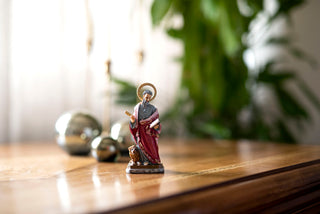St. Mark is one of the four Evangelists, together with St. Matthew, St. Luke and St. John. Celebrated every year on 25 April, he is considered the Patron Saint of Barristers, Notaries, Venice (Italy) and Egypt.
Do you know everything about this important Catholic Saint?
If not, read our blog post to discover more about the second of the four Evangelists.
 St. Mark the Evangelist statue, Cathedral of Segovia (Spain).
St. Mark the Evangelist statue, Cathedral of Segovia (Spain).
Life of St. Mark the Evangelist
St. Mark, whose name comes from Green Μᾶρκος is the traditionally ascribed author of the Gospel of Mark (or Gospel According to Mark), the second Gospel contained in the New Testament. He is said to have founded the Church of Alexandria (the Coptic Christians of Egypt) and for this reason he is considered the Patron Saint of Egypt. Celebrated on 25 April, his symbol is the winged lion, a figure of courage that represents Jesus’ resurrection.
There are several theories about the identity of Mark the Evangelist.
- According to William Lane (1974), the Evangelist is identified with John Mark, the cousin of Barnabas, one of the prominent Christian disciples in Jerusalem.
- Hippolytus, instead, says he belonged to the “Seventy Disciples” who were sent out by Jesus to spread the Word of God in Judea.
- Eusebius of Caesarea says that St. Mark was an interpreter and a travel companion of St. Peter. He wrote down the sermons of Peter, thus composing his Gospel, before he left for Alexandria (Egypt) where he founded the Coptic Orthodox Church. He says, as well, that Mark was succeeded by Anianus as the bishop of Alexandria in the eighth year of Nero (62/63), probably due to his coming death. According to Coptic tradition, St. Mark was martyred in 68 AD.
- If we follow what is written in the Acts (15:39) we can read that Mark went to Cyprus with Barnabas after the Council of Jerusalem.
- According to tradition, in 49 AD, Mark traveled to Alexandria and founded the Greek Orthodox Church of Alexandria of which he became the first bishop and was honored as the founder of Christianity in Africa.
The Miracle of St. Mark
Beside being an Evangelist, St. Mark’s life has been marked by an amazing miracle he caused, depicted in the Tintoretto’s painting “Miracle of the Slave” (down here).
 Miracle of the Slave by Tintoretto (Gallerie dell’Accademia, Venice, Italy).
Miracle of the Slave by Tintoretto (Gallerie dell’Accademia, Venice, Italy).
In the scene above, we can see the Saint who intervenes making invulnerable a slave lying naked on the ground, who is about to be martyred by his master, with the blinding and shattering of the limbs, for having venerated the Saint's relics.
Thanks to St. Mark's intervention, the tools of martyrdom (the sharp points that should have blinded him and the hammers that should have broken his legs) break, becoming useless.
It is on the figure of the Saint who bursts from the sky that Tintoretto condenses his attention by representing him in flight upside down with a daring glimpse, leaning towards the body of the slave.
Prayer & Novena to St. Mark the Evangelist
Patron Saint of Lawyers and Notaries, the Saint Mark’s Novena starts on 16 April and ends on 24 April, just the day before his Feast day (25 April).
If you want to praise this Saint, you can recite this beautiful prayer:
preaching the Good News of Christ.
May you help us to know Him well
so that we may faithfully live our lives
as followers of Christ.
Are you devoted to St. Mark the Evangelist?
You cannot miss the religious statue that depicts this Saint, entirely realized in hand-painted resin. This St. Mark statue represents the Evangelist while holding his Gospel on the left hand and with the winged lion at his feet, the attribute that symbolizes him.
Related articles:
Who are the four Evangelists? →
The Patron Saints of the Eternal City: St Peter & St Paul →



